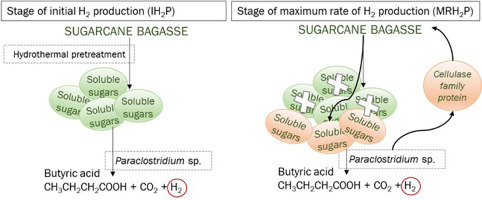当前位置:
X-MOL 学术
›
Sci. Total Environ.
›
论文详情
Our official English website, www.x-mol.net, welcomes your feedback! (Note: you will need to create a separate account there.)
Isolation of Paraclostridium CR4 from sugarcane bagasse and its evaluation in the bioconversion of lignocellulosic feedstock into hydrogen by monitoring cellulase gene expression.
Science of the Total Environment ( IF 9.8 ) Pub Date : 2020-01-24 , DOI: 10.1016/j.scitotenv.2020.136868 Camila Abreu B Silva Rabelo 1 , Cintia Hiromi Okino 2 , Isabel Kimiko Sakamoto 1 , Maria Bernadete Amâncio Varesche 1
Science of the Total Environment ( IF 9.8 ) Pub Date : 2020-01-24 , DOI: 10.1016/j.scitotenv.2020.136868 Camila Abreu B Silva Rabelo 1 , Cintia Hiromi Okino 2 , Isabel Kimiko Sakamoto 1 , Maria Bernadete Amâncio Varesche 1
Affiliation

|
Bioconversion of sugarcane bagasse (SCB) into hydrogen (H2) and organic acids was evaluated using a biomolecular approach to monitor the quantity and expression of the cellulase (Cel) gene. Batch reactors at 37 °C were operated with Paraclostridium sp. (10% v/v) and different substrates (5 g/L): glucose, cellulose and SCB in natura and pre-heat treated and hydrothermally. H2 production from glucose was 162.4 mL via acetic acid (2.9 g/L) and 78.4 mL from cellulose via butyric acid (2.9 g/L). H2 production was higher in hydrothermally pretreated SCB reactors (92.0 mL), heat treated (62.5 mL), when compared to in natura SCB (51.4 mL). Butyric acid (5.8, 4.9 and 4.0 g/L) was the main acid observed in hydrothermally, thermally pretreated, and in natura SCB, respectively. In the reactors with cellulose and reactors with hydrothermally pretreated SCB, the Cel gene copy number 3 and 2 log were higher, respectively, during the stage of maximum H2 production rate, when compared to the initial stage. Differences in Cel gene expression were observed according to the concentration of soluble sugars in the reaction medium. That is, there was no gene expression at the initial phase of the experiment using SCB with 2.6 g/L of sugars and increase of 2.2 log in gene expression during the phases with soluble sugars of <1.4 g/L.
中文翻译:

从甘蔗渣中分离出副梭菌CR4,并通过监测纤维素酶基因表达来评估木质纤维素原料向氢的生物转化。
使用生物分子方法评估了蔗糖蔗渣(SCB)向氢(H2)和有机酸的生物转化,以监测纤维素酶(Cel)基因的数量和表达。37℃下的分批反应器与副梭菌属sp一起运行。(10%v / v)和不同的底物(5 g / L):自然界中的葡萄糖,纤维素和SCB,并进行预热处理和水热。葡萄糖通过乙酸(2.9 g / L)产生的H2为162.4 mL,纤维素通过丁酸(2.9 g / L)产生的78.4 mL。与天然SCB(51.4 mL)相比,水热处理的SCB反应器(92.0 mL),热处理(62.5 mL)的H2产量更高。丁酸(5.8、4.9和4.0 g / L)是分别在水热处理,热处理和自然SCB中观察到的主要酸。在具有纤维素的反应器和具有水热处理的SCB的反应器中,与初始阶段相比,在最大H2产生速率阶段,Cel基因拷贝数3和2 log分别更高。根据反应介质中可溶性糖的浓度,观察到Cel基因表达的差异。也就是说,在实验的初始阶段,使用SCB和2.6 g / L的糖时没有基因表达,而在可溶性糖<1.4 g / L的阶段中,没有增加基因表达2.2 log。
更新日期:2020-01-24
中文翻译:

从甘蔗渣中分离出副梭菌CR4,并通过监测纤维素酶基因表达来评估木质纤维素原料向氢的生物转化。
使用生物分子方法评估了蔗糖蔗渣(SCB)向氢(H2)和有机酸的生物转化,以监测纤维素酶(Cel)基因的数量和表达。37℃下的分批反应器与副梭菌属sp一起运行。(10%v / v)和不同的底物(5 g / L):自然界中的葡萄糖,纤维素和SCB,并进行预热处理和水热。葡萄糖通过乙酸(2.9 g / L)产生的H2为162.4 mL,纤维素通过丁酸(2.9 g / L)产生的78.4 mL。与天然SCB(51.4 mL)相比,水热处理的SCB反应器(92.0 mL),热处理(62.5 mL)的H2产量更高。丁酸(5.8、4.9和4.0 g / L)是分别在水热处理,热处理和自然SCB中观察到的主要酸。在具有纤维素的反应器和具有水热处理的SCB的反应器中,与初始阶段相比,在最大H2产生速率阶段,Cel基因拷贝数3和2 log分别更高。根据反应介质中可溶性糖的浓度,观察到Cel基因表达的差异。也就是说,在实验的初始阶段,使用SCB和2.6 g / L的糖时没有基因表达,而在可溶性糖<1.4 g / L的阶段中,没有增加基因表达2.2 log。


























 京公网安备 11010802027423号
京公网安备 11010802027423号